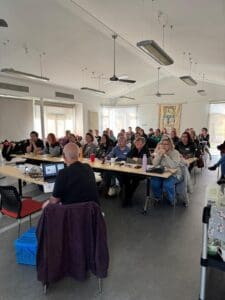The Eastern Grey Kangaroo (Macropus giganteus) is a familiar and iconic sight across Victoria, including the Macedon Ranges 6. These large marsupials are often seen grazing in open grasslands, woodlands, and even farmland areas, adding to the natural charm of our region 6.
Eastern Grey Kangaroos are impressive animals, with adults ranging from 3 to 7.5 feet in height, although females are typically two to three times smaller than males 38. Males can weigh up to 187 lbs, while females reach around 93 lbs 38. They have thick fur that is usually grayish-brown across most of their bodies, with lighter, sometimes white underparts 38. Their faces can be darker, and the tips of their paws, feet, and tails are also dark 38. They have small heads with large, swiveling ears that enhance their hearing, and long eyelashes that protect their eyes from dust and sunlight 38. Their powerful hind legs and large hind feet enable them to move quickly and efficiently, reaching speeds of up to 30 miles per hour 38. Their long and strong tails provide balance when hopping and act as a “kickstand” when standing still or moving slowly 38. The front legs are much smaller but are used for grasping food and aiding in movement at slower speeds 38.
Eastern Grey Kangaroos can be found widely across Victoria, including the Macedon Ranges 6. They live in social groups called mobs, which can consist of 10 or more individuals 6. Their habitat ranges from semi-arid mallee scrub through to woodlands and farmland areas, demonstrating their adaptability 6. Hanging Rock, also known as Mount Diogenes, is a particularly great place to spot these kangaroos 6. They often graze in open areas where grasses are plentiful, with nearby patches of trees providing cover 39. Smaller groups may join together to graze in preferred foraging areas and rest in larger groups during the middle of the day 40.
Eastern Grey Kangaroos are primarily herbivores, with a diet consisting of grasses, herbs, and occasionally shrubs 38. They are browsers and have a varied diet, primarily feeding on different types of grasses 38. Their food is well-chewed before being swallowed and digested 39.
Kangaroos are gregarious animals and form open-membership groups 40. They have excellent hearing and use vocal sounds to communicate with each other 38. Adult kangaroos use clucking sounds for communication within the group and with their young 38. Competing males and alarmed kangaroos may make a deep coughing sound 38. When feeling threatened, they will often stamp their back legs on the ground as a warning signal 38. Eastern Grey Kangaroos can breed year-round, with most births occurring during spring and early summer 38. Like all marsupials, they have a short gestation period of about 36 days 38. The baby kangaroo, called a joey, is born very small and hairless, about the size of a peanut 38. Immediately after birth, the joey climbs into the pouch on its mother’s belly and attaches to one of the four nipples, where it stays to nurse and grow for more than four months 38. Around six months old, the joey’s eyes begin to open, and it will start to venture out of the pouch for short periods before returning for safety and nourishment 38.
While Eastern Grey Kangaroos are not currently listed as threatened, their populations can fluctuate with the availability of food and water 3. They can sometimes come into conflict with humans, particularly in agricultural areas, and are also vulnerable to road collisions 7. Fences can also pose a hazard, and wildlife-friendly fencing designs are important to allow kangaroos to pass through safely 17.
The Macedon Ranges Wildlife Network recognizes the importance of coexisting peacefully with kangaroos. We provide information and advice on living with wildlife, including kangaroos, and promote wildlife-friendly fencing practices 3.
You can help ensure the well-being of Eastern Grey Kangaroos in the Macedon Ranges by driving cautiously, especially in areas where they are commonly seen 7. If you have fencing on your property, consider using wildlife-friendly designs that allow kangaroos to pass through without getting injured 7. Observe kangaroos from a respectful distance and avoid feeding them, as this can disrupt their natural behaviors and make them dependent on human handouts. By understanding and respecting these magnificent marsupials, we can continue to enjoy their presence in the Macedon Ranges for years to come.


